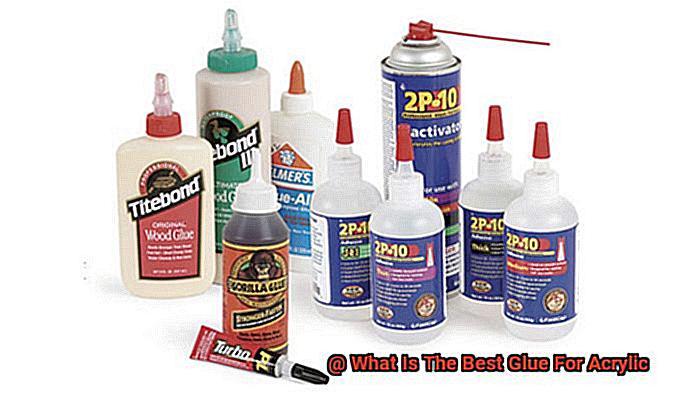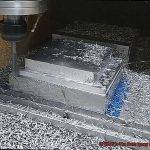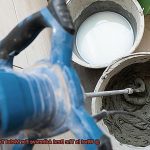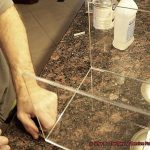Choosing the perfect glue for your acrylic project is essential for a strong and lasting bond.
But with so many options out there, it can be overwhelming to find the right one. Don’t worry, though.
We’ve got you covered. In this blog post, we’ll take a deep dive into the world of acrylic adhesives.
We’ll explore different types of glue specifically designed for acrylic materials, weighing their pros and cons. Whether you’re a DIY enthusiast, fixing up some acrylic products, or even creating stunning artwork, we’ll help you find the best glue for your unique needs.
So, let’s jump in and discover the secret to perfecting your acrylic bonds.
What is Acrylic?
Contents
- 1 What is Acrylic?
- 2 Why is it Important to Choose the Right Glue for Acrylic?
- 3 Solvent-Based Adhesives
- 4 Super Glue
- 5 Other Factors to Consider when Choosing the Best Glue for Acrylic
- 6 Different Types of Acrylics and their Bonding Requirements
- 7 Proper Surface Preparation for Bonding Acrylics
- 8 Testing the Bond Before Applying the Glue to a Project
- 9 Conclusion
Acrylic, derived from polymethyl methacrylate (PMMA), is a remarkable material that finds its place in a multitude of industries and applications. It is a type of plastic known for its exceptional clarity, durability, and weather resistance. With its glass-like appearance and superior strength, acrylic has become a popular choice for various purposes.
One of the standout features of acrylic is its transparency. Unlike other plastics, acrylic boasts excellent light transmission properties, mimicking the clarity of glass. This makes it ideal for applications where aesthetics and visibility are paramount, such as windows, display cases, and signage.
In addition to its transparency, acrylic offers exceptional strength. Unlike glass, it is highly resistant to breakage or shattering, making it a reliable choice for safety barriers, protective shields, and bullet-resistant glazing.
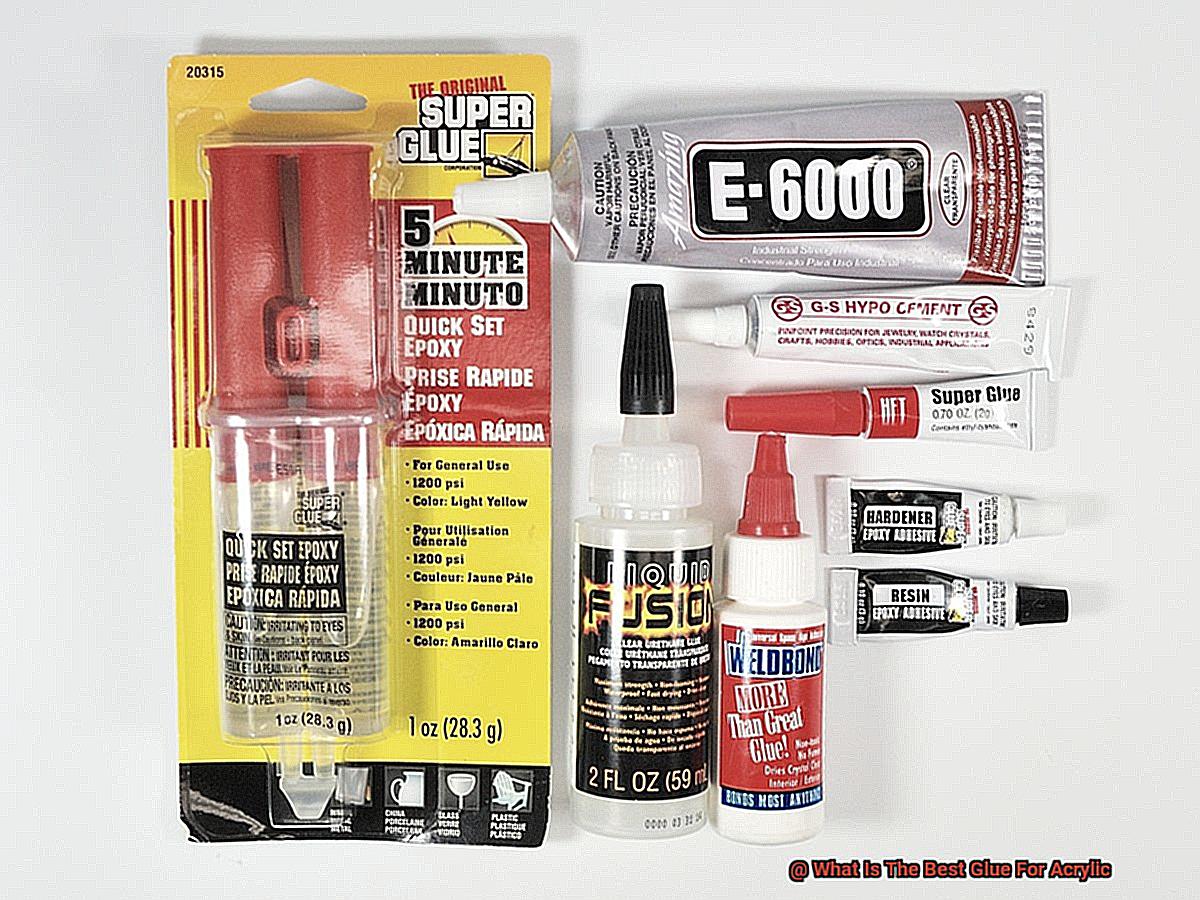
Acrylic’s resilience extends to its weathering capabilities. Unlike some plastics that deteriorate over time when exposed to sunlight, acrylic maintains its clarity and strength even after prolonged outdoor exposure. This makes it an excellent material for outdoor signs, architectural installations, and aircraft windows.
Another remarkable property of acrylic is its versatility in fabrication and processing. It can be easily molded into various shapes using techniques like injection molding or thermoforming. This allows manufacturers to create complex designs and customized products effortlessly. Acrylic can also be cut, drilled, polished, and bonded using adhesives formulated specifically for acrylic materials.
Acrylic’s chemical resistance sets it apart as well. It can withstand acids, alkalis, and other chemicals, making it suitable for use in laboratories or chemical processing environments. Additionally, it can withstand high temperatures without deforming or melting, making it a reliable choice for heat-resistant applications.
Why is it Important to Choose the Right Glue for Acrylic?
Acrylic, the superhero of plastics, possesses remarkable qualities that make it a top choice for various applications. From its glass-like appearance to its ability to withstand harsh elements, acrylic is a versatile material. However, to ensure the longevity and integrity of your acrylic projects, it is crucial to choose the right glue. In this blog post, we will explore why selecting the appropriate adhesive is essential and the potential consequences of using the wrong glue.
Strong and Durable Bonds:
Using the wrong adhesive can result in weak bonds, causing acrylic pieces to come apart easily. Acrylic glues are specifically formulated to create robust and long-lasting bonds that can withstand stress and strain. They provide the strength needed for acrylic’s unique properties.
Aesthetics Matter:
The right glue not only provides a strong bond but also creates a seamless and invisible joint. This is crucial for applications where aesthetics matter, such as constructing display cases or signage. Choosing the wrong glue can lead to discolored or brittle bonds, ruining the overall appearance of your project. Don’t let your carefully crafted acrylic project be marred by an unsightly bond.
Material Protection:
Using an inappropriate adhesive can cause damage to the acrylic surface, including cracking or crazing. This not only compromises the appearance but also weakens the structural integrity of your project. Protect your investment by choosing a glue specifically designed for acrylic that won’t harm its surface.
Long-Term Durability:
Selecting the right glue ensures that your project will stand the test of time. Some adhesives may yellow or deteriorate over time when exposed to sunlight or other environmental factors. By choosing an adhesive specifically formulated for acrylic, you minimize the risk of deterioration and ensure your project remains intact for years to come. Don’t let your hard work fade away.
Safety First:
Certain adhesives contain harsh chemicals that release toxic fumes during curing. Using a glue formulated for acrylic minimizes this risk and promotes a safer working environment. Protect yourself and those around you by choosing a glue that prioritizes safety without compromising performance.
Solvent-Based Adhesives
When it comes to bonding acrylic, you need an adhesive that can stand the test of time, ensuring a seamless and durable bond. Enter solvent-based adhesives, the superheroes of the adhesive world. In this blog post, we will explore the benefits and considerations of using solvent-based adhesives for bonding acrylic, providing you with all the information you need to make an informed decision.
Benefits of Solvent-Based Adhesives for Acrylic Bonding:
- Durability: Solvent-based adhesives excel in creating long-lasting bonds with acrylic materials. Their powerful solvents penetrate the surface of the acrylic, forming a strong chemical bond that is impervious to moisture, heat, and other environmental factors. This ensures that your project remains intact, even in the harshest conditions.
- Fast Curing Time: Time is precious, especially when it comes to assembly and production processes. Solvent-based adhesives offer rapid curing times, allowing for quick project completion. Once applied, the solvents evaporate, leaving behind a solid and robust bond in no time.
Considerations when Using Solvent-Based Adhesives for Acrylic Bonding:
- Ventilation: Due to the presence of volatile organic compounds (VOCs) in solvent-based adhesives, it is crucial to work in a well-ventilated area or under proper extraction systems. This helps minimize exposure to harmful fumes and ensures a safe working environment where you can unleash the power of these adhesives without compromising your health.
- Compatibility Testing: While solvent-based adhesives generally work well with most acrylic materials, it is essential to conduct compatibility testing before applying them to larger surfaces. This ensures that the adhesive does not cause any unsightly discoloration or damage to the beautiful acrylic you’re working with. Take the time to test a small, inconspicuous area to guarantee a picture-perfect finish.
Super Glue
Step into the realm of adhesive superheroes and discover the mighty power of super glue. In this comprehensive guide, we will delve into the world of super glue, exploring its pros and cons for bonding acrylic materials. Get ready to be captivated by its lightning-fast bonding capabilities and learn how to harness its strength for your DIY projects.
Pros:
- Lightning-Fast Bonding: Look no further than super glue for instant gratification. Within a matter of seconds, this adhesive superhero forms an unbreakable bond between acrylic surfaces, allowing you to wield your creations immediately. Say goodbye to lengthy waiting times and embrace the swift satisfaction of super glue.
- Simplicity Personified: Applying super glue is as easy as counting to three. Just a tiny squeeze onto one surface, a firm press together, a few seconds of patience, and behold. A secure bond materializes before your eyes. Its simplicity makes it an ideal choice for beginners who desire hassle-free adhesion.
- Boundless Versatility: While specialized acrylic adhesives are recommended for optimal results, super glue can still conquer diverse materials with ease. From metal to plastic, wood to acrylic, this adhesive powerhouse showcases its versatility by bonding them all. No matter the project at hand, rest assured that super glue has got your back.
Cons:
- Taming the Flexibility Beast: Strength comes at a price – in the case of super glue, flexibility is sacrificed. Although it forms a robust bond, it struggles to endure significant stress or movement. Larger or load-bearing applications may demand a more flexible adhesive, leaving super glue’s rigidity in the shadows.
- The Art of Surface Preparation: A successful bond requires meticulous surface preparation when using super glue on acrylic materials. Bid farewell to oils and contaminants that could hinder the bonding process. Ensure that the surfaces are pristine, clean slates, ready to embrace the power of super glue.
- The Enigma of Bond Strength Variability: Super glue’s bonding strength is a captivating enigma influenced by factors like surface texture and temperature. Before embarking on grand-scale projects, it is wise to test the adhesive on a small area to unlock its true potential. Embrace the power of experimentation to achieve optimal results.
Other Factors to Consider when Choosing the Best Glue for Acrylic
Let’s explore the other factors you need to consider when selecting the perfect adhesive for acrylic.
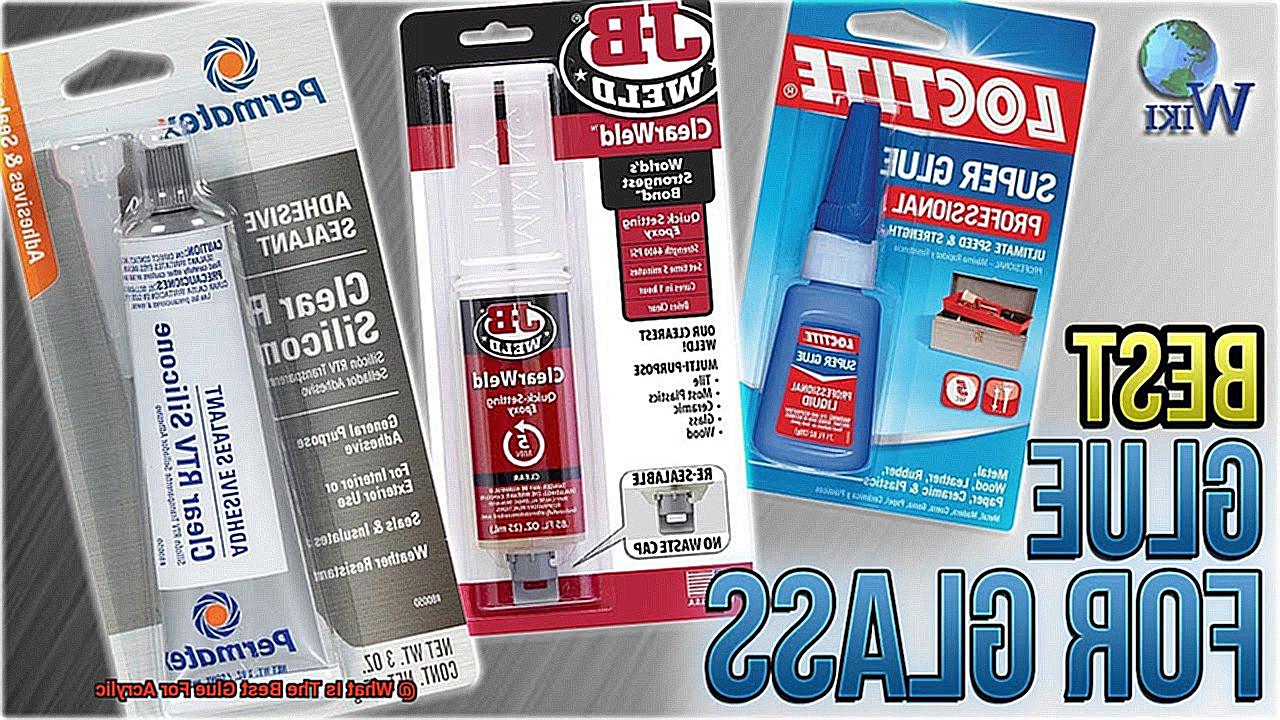
- Compatibility: Acrylic is a special type of plastic that requires a specific adhesive for optimal bonding. Look for a glue specifically formulated for acrylic to ensure compatibility and achieve the best results.
- Drying Time: We all know how impatient we can get when working on a project. Consider the drying time of the glue, as different glues have varying set times. Factors like temperature and humidity can affect drying time, so choose a glue that suits your project’s needs.
- Bond Strength: If you want your acrylic creation to withstand the test of time, bond strength is crucial. Different glues offer different levels of strength, so assess your project requirements carefully before making a choice.
- Clarity: Crafting or creating acrylic displays? Maintain that crystal-clear appeal by choosing a clear or transparent adhesive designed specifically for acrylic. Avoid visible residue or cloudy appearances that could ruin your masterpiece.
- Application Method: Some glues come in squeeze bottles, while others require brushes or applicators for precise application. Choose a glue with an application method that suits your preferences and project requirements.
- Toxicity and Odor: Working in an enclosed space or having sensitivity to certain chemicals? Look for a glue that is safe to use and doesn’t emit strong fumes or contain toxic ingredients.
- Storage and Shelf Life: Consider the storage requirements and shelf life of the glue. Some glues have specific temperature or storage conditions, and others have a limited shelf life once opened. Keep these factors in mind to ensure your glue remains effective for future projects.
Different Types of Acrylics and their Bonding Requirements
Acrylic is a versatile material used in various industries, but finding the right adhesive can be challenging due to its smooth and non-porous nature. In this guide, we will delve into the different types of acrylics available in the market and explore their specific bonding requirements. Understanding these nuances will help you make an informed decision when choosing the best adhesive for your acrylic projects.
Cast Acrylic: Crystal Clarity and Solvent-Based Adhesives
Cast acrylic is renowned for its high optical clarity and dimensional stability. To bond cast acrylic effectively, solvent-based adhesives are recommended. These adhesives, such as methyl methacrylate (MMA) or dichloromethane (DCM) based adhesives, work by dissolving the surface of the acrylic, creating a robust bond when the solvent evaporates. Brands like Weld-On 3 or IPS Weld-On 16 are specifically designed for bonding cast acrylic, ensuring a secure connection without compromising its crystal-clear appearance.
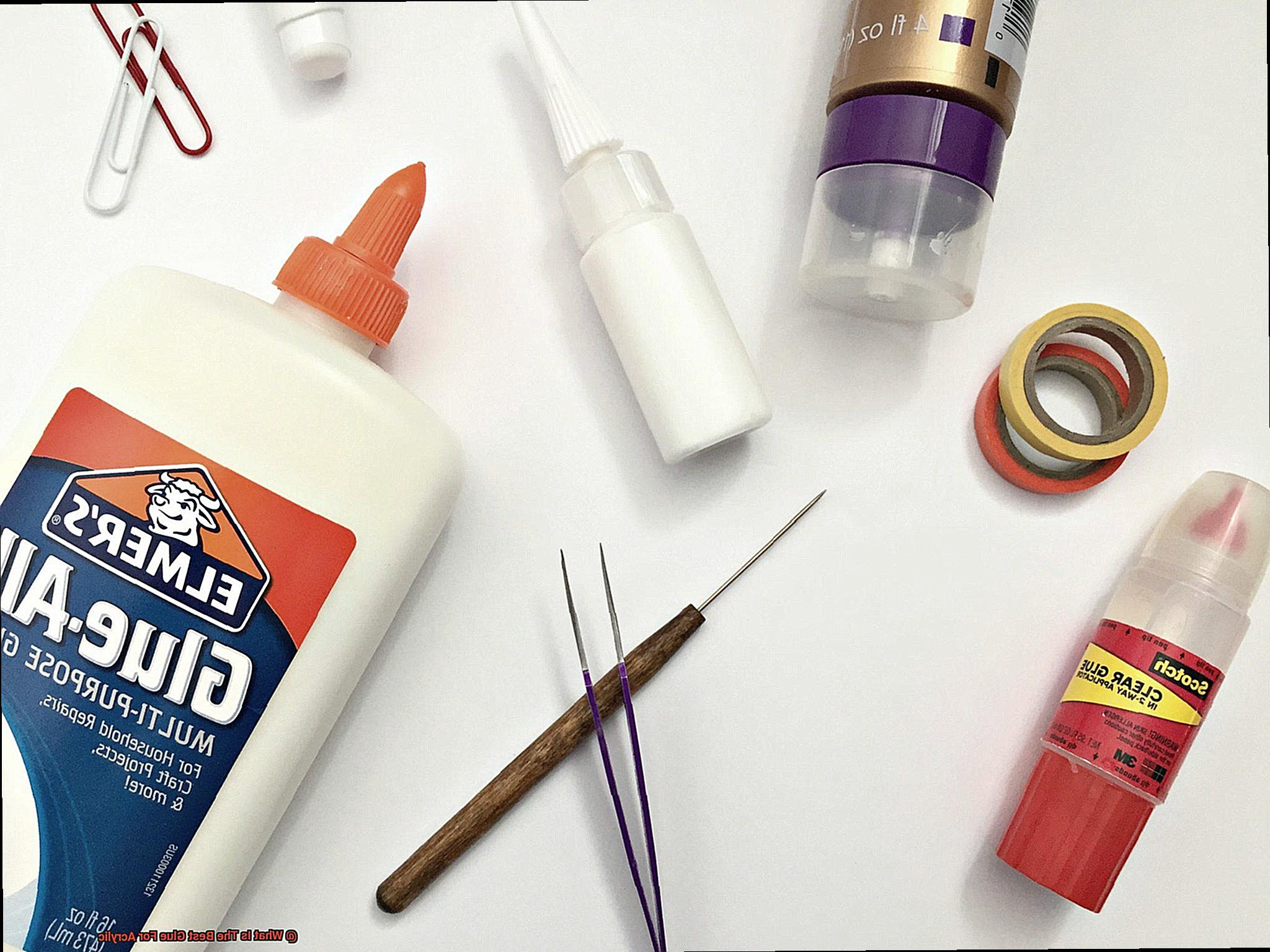
Extruded Acrylic: Durability and Solvent-Based Adhesives
Extruded acrylic, while slightly less optically clear than cast acrylic, offers excellent impact resistance. Similar to cast acrylic, solvent-based adhesives can be used to bond extruded acrylic effectively. By melting the surface of the acrylic, these adhesives create a strong bond that ensures durability in various applications.
Thicker Acrylic Sheets: Epoxy and Structural Acrylic Adhesives
When working with thicker acrylic sheets, traditional solvent-based adhesives may not penetrate the entire surface area effectively. In these cases, using a two-part epoxy adhesive or a structural acrylic adhesive is recommended. These adhesives create a chemical reaction between their components, resulting in a strong bond that can withstand heavy loads and stress.
Clear Bonding with UV-Curing Adhesives
Maintaining the optical clarity of cast acrylic is crucial for certain applications. UV-curing adhesives, such as Loctite 3492 or Permabond UV632, provide a clear bond while ensuring the material’s visual integrity. These adhesives require exposure to ultraviolet light to cure and form a solid connection.
Surface Preparation and Testing: The Key to Success
To ensure a strong and long-lasting bond, proper surface preparation is crucial. Clean the acrylic surfaces thoroughly, ensuring they are free from dirt, oils, or any contaminants that may hinder adhesion. Lightly roughening the surface can also improve the bonding strength. Additionally, it is essential to perform a small test on a scrap piece of acrylic before applying the adhesive to your project. This allows you to confirm compatibility and gauge the bond’s strength and durability.
Proper Surface Preparation for Bonding Acrylics
Proper surface preparation is the key to ensuring a strong and durable connection between your acrylic pieces. Let’s dive into the world of adhesives and discover the crucial steps for proper surface preparation.
Step 1: Cleanliness is Next to Bond-ness
Start by ensuring that your acrylic surfaces are squeaky clean. Use a mild detergent or soap to gently scrub away any dirt, oil, or grease. Harsh cleaners can scratch and damage the acrylic, so avoid them at all costs.
Step 2: Dry ‘Em Out
Moisture is the enemy of a good bond. Use a lint-free cloth or towel to thoroughly dry the surfaces. Give them a few minutes to air dry as well. This step ensures a solid connection.
Step 3: Smooth Operator
Smooth surfaces are essential for a strong bond. Use sandpaper or a file to get rid of any rough edges or imperfections. You want those acrylic pieces to fit together perfectly.
Step 4: Prime Time
Bring in the big guns – the primer. This magical substance is specially designed for bonding acrylics. Follow the manufacturer’s instructions for applying the primer and take your bond to the next level.
Step 5: Glue Galore
Choose a glue that specifically mentions acrylics on the label or product description. Solvent-based adhesives and two-part epoxy adhesives are popular choices because they offer strength and durability.
Step 6: Apply and Press
Apply a thin, even layer of adhesive to one of the acrylic surfaces. Press those pieces together firmly, using clamps or other tools to hold everything in place while the adhesive works its magic.
Step 7: Patience is a Virtue
Wait for the adhesive to cure completely before subjecting your bonded acrylics to any stress or pressure. The curing time will vary, so consult the manufacturer’s instructions for guidance.
Testing the Bond Before Applying the Glue to a Project
Testing the bond before applying the glue to a project is an essential step to ensure a successful and durable adhesive connection between acrylic materials. It is crucial to understand the importance of testing the bond in order to achieve the desired results.
First and foremost, testing the bond allows for the assessment of compatibility between the chosen glue and the acrylic surface. Acrylic is a unique material that requires specific adhesives capable of forming a strong bond without causing damage or discoloration. By testing the bond beforehand, you can determine if your chosen glue will adhere properly and provide a reliable connection. This step is crucial to avoid any potential issues or failures down the line.
In addition to compatibility, testing the bond is necessary to evaluate the strength and durability of the adhesive connection. Different types of glues offer varying levels of bonding power, and by testing the bond, you can ensure that your adhesive can withstand the demands of your project. Weak bonds or premature detachment can be detrimental to your hard work, so it’s important to test the bond to avoid disappointment.
To test the bond effectively, start by preparing small samples of acrylic material similar to what you’ll be using in your project. Clean these samples thoroughly to remove any contaminants that could affect adhesion. Apply a small amount of glue on one side of each sample, following the manufacturer’s instructions regarding curing time and application techniques.
Once the glue has cured, you can proceed with evaluating the bond’s strength. Apply pressure or stress on the glued area using different techniques such as pulling, twisting, or bending. Look out for any signs of weakness like visible gaps, cracks, or easy detachment. This testing process helps determine if the glue can withstand the anticipated stresses and strains in your specific project.
It is also important to consider factors like temperature and humidity during testing. Acrylic materials can expand or contract with changes in temperature, which may impact the adhesive connection over time. By subjecting your test samples to different environmental conditions, you can assess how well the bond holds up under varying circumstances.
hT6Ow_cBTps” >
Also Read: How To Glue Acrylic Together? – Glue Things
Conclusion
When it comes to finding the perfect adhesive for acrylic, there are a few options that stand out from the rest.
One of the top contenders is cyanoacrylate glue, also known as super glue. This powerful adhesive forms a strong bond quickly and securely, making it ideal for acrylic projects.
Another excellent choice is epoxy resin, which not only provides a durable bond but also allows for some flexibility when working with acrylic. And let’s not forget about solvent cement, a specialized glue specifically designed for bonding acrylic pieces together.
It creates a seamless and long-lasting connection between surfaces.

